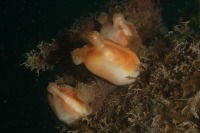
(Photo: Claire Goodwin)
Sea Peach
Halocynthia pyriformis
A solitary sea squirt. Their tunic (the outer coat) is smooth and shiny. Their barrel-shaped body can reach a height of 13 centimetres but they are usually around three or four centimetres. They are yellow, orange or red in colour, with parts of the tunic, especially between the siphons, brighter orange. They have two siphon openings on the top (an incurrent and an excurrent) which are almost square-shaped.
Authority
Rathke, 1806
Classification Details
Phylum: Chordata (chordates); Subphylum: Tunicata (tunicates); Class: Ascidiacea (sea squirts).
Habitat
Found attached to rocky substrate or human-made structures such as piers and weirs. From the intertidal zone to depths of over 180 metres (low intertidal to deep subtidal) but most common in depths of seven to 90 metres. Widespread in Arctic and North Atlantic waters. On North American coasts from the Arctic to Maine. In Europe found in the Arctic, Faroe Islands, and Iceland with Norway being the southern limit. In the Bay of Fundy they are very common and can be found in densities of up to 60 individuals per square metre.
Diet
Sea peaches are filter feeders, removing plankton from the water. They bring water in through their incurrent siphon, where they extract plankton. They then release the water through their excurrent siphon.
Reproduction
Individuals are hermaphroditic, containing both male and female sex organs in one individual. They are capable of both cross- and self-fertilization, although cross-fertilization is more common. They expel eggs and sperm into the water column, where fertilization takes place. The eggs then develop into planktonic tadpole-like larvae. They do not feed while in the larval stage, but instead rely on the yolk supplied with the egg. The larvae find a place to settle before metamorphosing into the benthic adult form.
Fun Facts
When touched or otherwise disturbed, they can retract their siphons very quickly. This sometimes squirts water out, giving rise to the nickname sea squirts.
References
Armsworthy SL, MacDonald B and Ward JE (2001) Feeding activity, absorption efficiency and suspension feeding processes in the ascidian, Halocynthia pyriformis (Stolidobranchia: Ascidiacea): Responses to variations in diet quantity and quality. Journal of Experimental Marine Biology and Ecology 260, 41–69.
Lemaire P (2011). Evolutionary crossroads in developmental biology: the tunicates. Development 138, 2143–2152.
Ma, KCK, Deibel D, Law K, Aoki M, McKenzie CH and Palomares MLD (2017) Richness and zoogeography of ascidians (Tunicata: Ascidiacea) in eastern Canada. Canadian Journal of Zoology 95, 51–59.
Van Name WG (1945) The north and south American Ascidians. Bulletin of the American Museum of Natural History 84, 1–476.


